This year, the coveted "Eager Beaver" prizes go to the following species:
Astragalus arnottianus - surface sown at room temperature after scarifying; 2 seeds germinated after 1 day; 11 seeds germinated on the second day.
The runner up is:
Convolvulus tragacanthoides - seeds surface sown at room temp after scarifying; 1 seed germinated on 2nd day after sowing.
Other impressive showings:
Oxytropis prenja - seeds surface sown at room temp after scarifying; 1 seed germinated on 3rd day after sowing, 5 seedlings on the 4th day.
Trifolium macrocephalum - seeds surface sown at room temp after scarifying; 1 seed germinated on 3rd day after sowing, 2 seedlings on the 4th day.
In the non-Fabaceae category the winner is:
Dracocephalum discolor - seeds surface sown at room temperature; 11 seeds germinated on the 3rd day after sowing!
The runner up is:
Alyssoides utriculata - seeds surface sown at room temperature; germination started on the 4th day after sowing.
It's fun to have some seedlings to keep an eye on!
Comments
No real eager beavers here,
No real eager beavers here, but some have germinated.
Indigofera heterantha in 4 days after rubbing seeds on sandpaper and onto vermiculite soaked in 6 ppm GA-3
at 20 C or 70 F
Rhododendron campanulatum on vermiculite soaked 660 ppm GA-3 at 20 C or 70 F in 22 days.
Rhododendron wightii same conditions and also 22 days.
Calceolaria biflora on moist vermiculite at 17 C or 65 F in 13 days.
Bukiniczia cabulica on moist vermiculite at 20 C or 70 F in 7 days.
Now THAT one takes the early
Now THAT one takes the early bird prize, Bob! What astounding longevity!
Well done, Caroline. I've never managed to germinate any rhododendron seed yet, in my fitful attempts. Glad the calceolaria germinated for you - a very cool and hardy plant.
It was amazing how quickly
It was amazing how quickly these germinated. It reminded me of those horror movies where someone awakes a long-sleeping demon. (Not that I watch a lot of those.)
Sowing on filter paper saves me the trouble of sowing in pots and then wondering why nothing has happened. I transfer the seedlings to pots the next day. Tried this method outdoors, in May or June, sowing germinated seeds into the garden, but something finds little astragalus seedlings very tasty. A pity, because taprooted plants have an easier time if their roots aren't disturbed.
Correction: the seed was collected in 1988, not 1986.
Wow Bob, truly testing
Wow Bob, truly testing an extreme! And with such youthful vigor!
Nice results, Carol. Was that a typo, with one at 6ppm GA3 and one at 660ppm GA3?
I've only grown Rhododendrons from seed once many many years ago, and didn't do anything special. Pure peat, R. schlippenbachii, surface sown and enclosed in a plastic bag. It was very successful. Very tiny plants, though. Gave the seedlings away, as I have no place suitable to plant them.
Thank you for the fresh seeds
Thank you for the fresh Calceolaria biflora seeds, Lori!
Fresh seeds make all the difference!
That is not a typo.
That is not a typo.
I did not think that the Indigofera needed it ----so used dilute.
Attached, a germinating seed
Attached, a germinating seed of Sclerocactus mesae-verdae. I've sowed seed of this stupid cactus pretty much every winter for the last 25 years and nothing has happened, so I chipped a few and they germinated within about four days. Lesson learned.
Now I have some seed of Cumulopuntia boliviana collected at about 10,000 feet in Argentina (so probably not hardy), but after fiddling with the incredibly hard seed coat it looks like smashing it with a hammer might be the best way to go.
Since I've been using a the
I've been using a the Kew Seed Information Database a lot lately (http://data.kew.org/sid/), and I' have been finding that they scarify, chip or otherwise remove seed coatings more often than what most of us are used to. And often it is done after the an initial "water imbibing" treatment. Apparently this "water imbibing" is just to soften the coat.
That's what you do with
That's what you do with oncocyclus iris, before cutting them. (Idiot that I am, I sowed dozens upon dozens of these seeds outdoors, with disappointing results, not realizing that I could get germination in a couple of days simply by cutting them.) I'm soaking the cumulopuntia seed to see if the seed coat, which is hard as a rock, will soften enough so that maybe I can cut one open to see which end is which. It's like a miniature walnut.
With fabaceous stuff, I nick first and soak second. The seedlings usually die when I plant them out in the garden, but at least I germinated the seed ....
The oncocyclus, mostly from
The oncocyclus, mostly from Archibald collections, ca. 2000 or 2001, I think.
Yeah, Dracocephalum discolor
Yeah, Dracocephalum discolor and Bukiniczia cabulica were among my quick germinators, too. By the way, I've germinated and killed Bukiniczia more times than I care to remember. Any tips on getting it through a summer and winter?
Other quick ones included Sedum ussuriense (first germination in 3 days), oxytropis multiceps (scarified, 4 days), erigeron elegantulus (4 days), and the one seed of acantholimon saxifragiforme that was viable sprouted in 4 days too. Oh, and the gazania hybrid seeds that I inexplicably received (neither on my primary or alternative list), unsurprisingly were quick sprouters also (3 days or so).
By the way, Lori, most of the penstemon seeds you sent me last fall have now germinated, too - thanks again for the party pack! The only ones that are recalcitrant are the P. lyallii, which I had tried unsuccessfully before. Still holding out hope that they'll pop.
Ooooh, I'm deeply envious,
Ooooh, I'm deeply envious, Bob. Maybe some day...
Well, I have only one plant of Bukiniczia myself so I can hardly advise, Rob! Do they die out in the summer, or is it a problem with wintering over? I'm sure there are some participants or lurkers here who could help! Glad to hear the penstemons are doing well.
A few seedlings from this year's efforts - some of these have already been separated out into their own pots, since these photos:
Dracocephalum discolor; seeds germinated on the 3rd day after sowing at room temperature:
Silene davidii - more have germinated since the photo; seeds collected by V. Holubec at Zheduo Shan, Sechuan, China; germinated in 7 days after sowing at room temp:
Dracocephalum forrestii - seeds from M. Pavelka a few years ago; germinated at 6 days after sowing at room temp:
Convolvulus tragacanthoides on the right; seed collected by V. Holubec at Kyzul Tu, Terski AT, Kyrgyzstan; germinated at room temperature after scarification, in second day after planting:
Silene pusilla; from the NARGS seedex; germination at 4 days after sowing at room temp:
Erigeron aurantiacus; seed collected by V. Holubec at Chong Kemin, Kungei AT, Kyrgyzstan; germinated on 5th day after sowing at room temp:
Dracocephalum stamineum; seed collected by V. Holubec at Chonashu, Terski AT, Kyrgyzstan; germinated 9 days after sowing at room temp:
Alyssoides utriculata - seeds from Rick, thank you! Seeds surface sown at room temperature; germination started on the 4th day after sowing.
Oxytropis prenja - seeds from M. Pavelka a few years ago; seeds surface sown at room temp after scarifying; 1 seed germinated on 3rd day after sowing, 5 seedlings on the 4th day.
Astragalus arnottianus - seeds from V. Holubec, collected at Mendoza, Aconcagua, Argentina; surface sown at room temperature after scarifying; 2 seeds germinated after 1 day; 11 seeds germinated on the second day.
I know one Chapter member
I know one Chapter member here in Minnesota that has overwintered Bukiniczia cabulica at least once. She told me she put a clay pot over it for the winter to keep it drier.
I think I may have had a
I think I may have had a Bukiniczia overwinter once. But on most attempts, I don't even think they make it through their first summer. I don't keep things in pots though - they go out into a nursery area in late spring, where they have to contend with the elements...
Well, if it's not making it
Well, if it's not making it through the summer, generally, it does seem likely that it's suffering from too much moisture.
It does well here - not in my yard, yet, but in the Ferguson yard where it self seeds nicely in an alpine bed... probably much drier conditions here than where you live.
It would seem to me that you
It would seem to me that you don't need very high hopes....
If half the seed in half the pots germinate, there will still be plenty lots!
Those cactus seedlings are sure plumping up fast. How old are they?
They were sown in November.
They were sown in November. Echinocereus species germinate in a couple of days.
I used to sow them outdoors, getting maybe one or two seedlings per pot. Fiddled with GA3, got a little more germination, and a lot more etiolation. They don't need any of that.
Which I did not realize two years ago when I decided to get back into cactus germination. Ordered seed from Alplains and Mesa Garden; gave about 150 seedlings to DBG last year, but I still have about a thousand seedlings. (I admit this might be considered eccentric.) I don't have a greenhouse, so the seedlings are growing very slowly.Here's a picture of the rest of them. They're on a table so that they get plenty of afternoon sun.
Yowza! What a cactus
Yowza! What a cactus menagerie!
The claim that Deinanthe
The claim that Deinanthe seeds are ephemeral is exaggerated. These Deinanthe caerulea seeds were harvested in mid October 2014. The tiny seeds were kept in an open tea cup at room temperature for four months, until planting, 13 Feb, 2015. Germination on a moist paper towel started on 6 March.
Good info, Rick.
Good info, Rick.
Here's a seedling update, including a few non-alpines:
Morina longifolia - germinated after 10 days at room temperature:
Lysimachia ephemerum - germinated after 15 days at room temperature:
Monarda 'Lambada' - germinated at room temperature after a few days (didn't note how many):
Macrotomia echioides - started germinating in the cold room after 1 month:
Salvia caespitosa - germinated at room temperature after about 20 days
Supposed to be Stachys inflata though they don't look like the previous ones I've grown - starting germinating after ~1 month in cold room
Townsendia hookeri - started germinating after 4 days at room temperature
Berkheya purpurea - germination started at 10 days at room temperature:
Xylorhiza venusta - germination started in the cold room at just short of 4 weeks of stratification:
Thlaspi zaffranii - germination at room temp
Physaria kingii - germination started in 8 days at room temp
Thymus cilicicus - germination started on 3rd day at room temp
Alyssoides utriculata -
Erigeron aurantiacum -
Aster batangensis -
Aster diplostephioides -
Pyrethrum tatsiense -
Oxytropis prenja -
Silene davidii -
Astragalus arnottianus -
Silene pusilla -
Silene falcata -
Stenotus acaulis -
Achillea erba-rota -
Pyrethrum karelinii -
Viola eizanensis - Ha, these turned out to be an oddly-coloured (purplish-red) California poppy! Is some NARGS seed donor pulling my leg? ;-)
Campanula topaliana -
Iris halophila v. sogdiana -
Wow, that's a wonderful haul!
Wow, that's a wonderful haul! Is the iris one of the rare "easy" ones, or do you have special skills in iris germination? I doggedly keep trying new species, but have only rarely met with success...
No, I'm afraid I have no
No, I'm afraid I have no skills at Iris germination! This one is just pure dumb luck (and probably one of the easy ones - I wouldn't know). I had seeds of a couple of species last year, which I soaked and nicked - thought I was doing the right thing? - but got zilch. I kept the pots over and reused them, leaving the old tags in, just in case... this was one of the extremely few instances of my many duds from last year actually germinating this year.
Bob Nold is the Iris expert! Bob, I suspect you could just direct us to a forum message here in which you've already described the necessary technique, or if not, would you be so kind as to summarize, please?
These germinated in 52°F
These germinated in 52°F nights, 65°F days:
Gladiolus cunonis. From 2011 seed, emerged in 24 days. Every seed germinated!
Erigeron compositus Mt. Adam's Dwarf. Emerged in 6 days. I couldn't tell which seeds were good when I planted. I guess they all were!
Erigeron compositus Red Desert. Emerged in 7 days. These have even longer roots.
Erigeron uniflorus. Emerged in 9 days.
Thalictrum coreanum. Surface sowed with about 8mm of granite grit cover, emerged in 14 days. Planted at 3-4mm depth, 22 days.
Asyneuma limonifolia. Emerged in 15 days.
Hypericum uniflorum. Emerged in 11 days.
Anemone baldensis. Emerged in approximately 11 days.
Dracocephalum ruyschiana. Emerged in 9 days.
Lovely to see your
Lovely to see your 'youngsters' all....
[quote=Lori S.]
No, I'm afraid I have no skills at Iris germination! This one is just pure dumb luck (and probably one of the easy ones - I wouldn't know). I had seeds of a couple of species last year, which I soaked and nicked - thought I was doing the right thing? - but got zilch. I kept the pots over and reused them, leaving the old tags in, just in case... this was one of the extremely few instances of my many duds from last year actually germinating this
[/quote]
For me Pacific Coast Iris are easy and quick to germinate.Here's a photo taken today of seed, received from the recent SPCI seedex and sown a few weeks ago in early March without any soaking or injury ,just starting to push out a radicle.All the pots have some activity, so a couple years of growth and hopefully the first blooms will appear......
(I tipped out some mix and lifted/placed a few seeds on their sides to show the radicles....)
Mihuenia poeppigii. Sown 12
Initially, I wondered if I had gotten this one mixed up. With the terete (round) cotyledons and the seemingly "thorny emerging stem" between them, it looked more like a cactus.
Plantago patagonica from seed I collected in western Minnesota.
There is a story here, because I sent this wild collected seed to the NARGS seed ex, and I thought they were whole seeds at the time. When I went to plant the seed I had reserved for myself in April 2012 (the following spring), every "seed" had split in half, and there seemed to be nothing there! I was very embarrassed that I had sent non-viable seed to the seed ex. But I planted them anyway. I gave the seed a month in the fridge, then outside in mid May 2013. They germinated after two full winters outside, in April 2015.
Mihuenia poeppigii. Sown 12 Sept 2014. One seed emerged on 7 Oct, and did not survive our zone 4 winter. The rest emerged in unison the following spring, on 30 April 2015.
Lewisia rediviva wild collected seed in Washington state, emerged 9 April 2015 after planting the previous fall and wintering outside.
Arisaema sikokianum. Planted 13 February and placed in the fridge for one month. They emerged in five weeks at room temperature.
I got the suggestion of planting Deinanthe caerulea seed in a jar from an SRGC forum member. The seedlings stay so tiny for so long. The jar is only 4.5 inches long. They germinated in one month at room temperature. The seed is not ephemeral, as sources claim. The seed is my own, collected in October and kept in a glassine envelope at 60F until mid March (5 months), when I planted it.
(Yes, I'm 56 years old and I still play with my Lego blocks!)

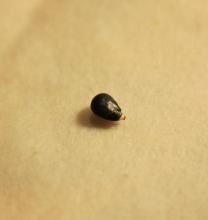
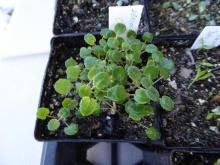
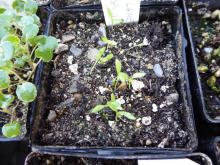
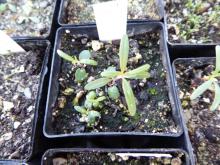
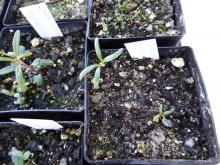
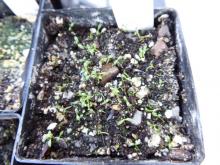
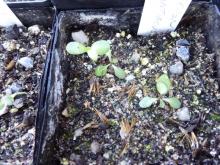
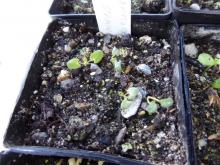
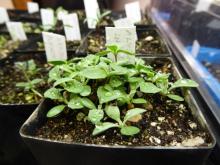
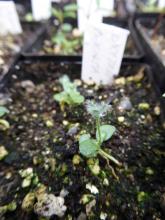
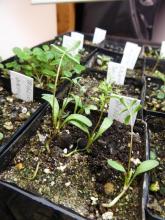
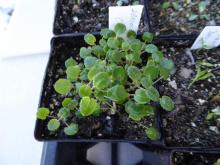
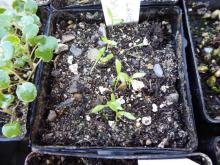
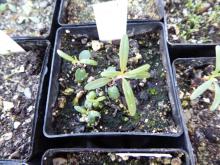
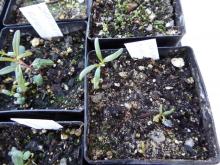
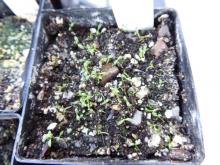
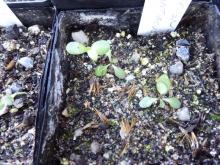
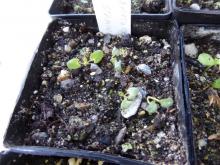
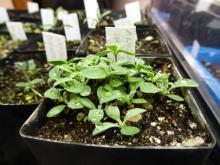
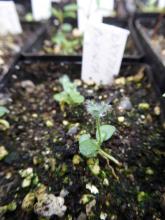
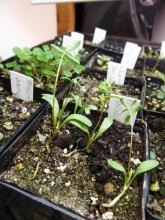

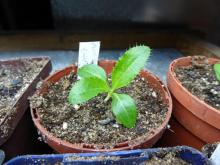
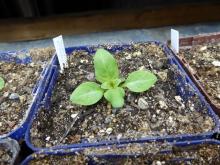
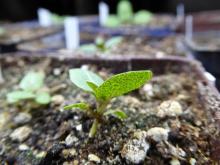
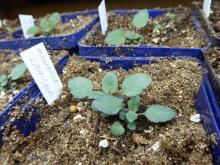
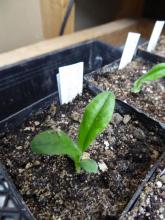
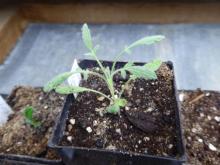
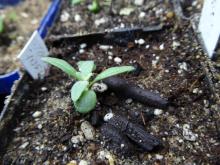
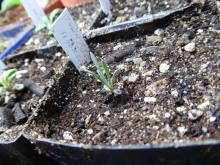
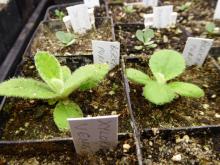
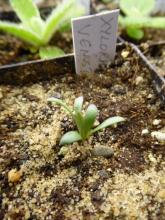
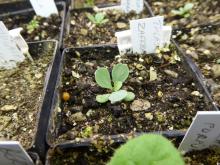
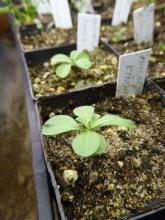
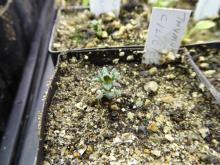
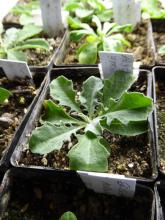
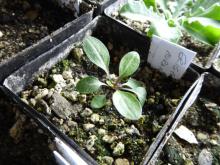
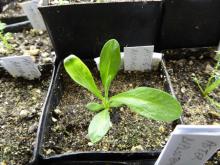
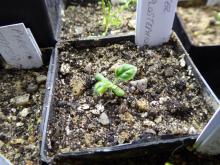
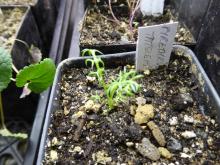
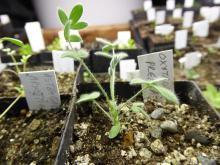
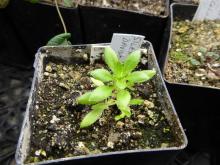
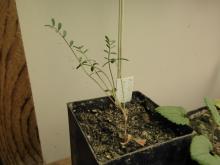
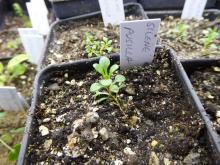
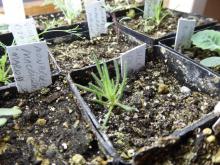
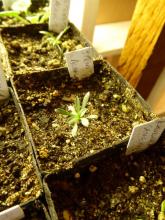
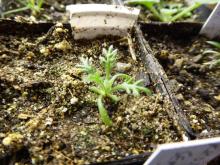
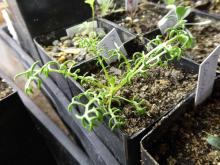
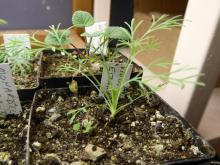
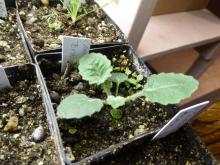
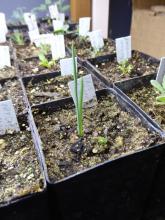
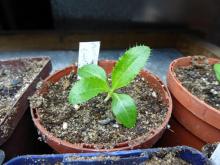
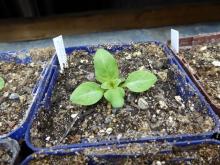
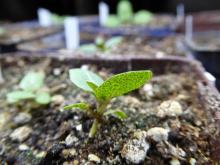
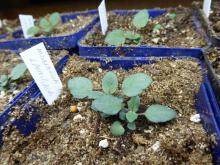
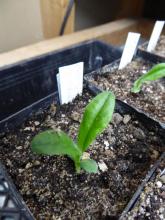
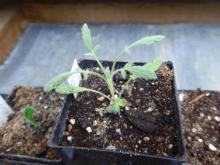
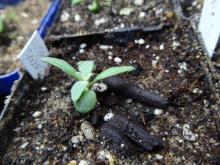
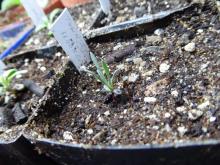
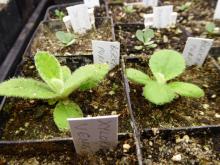
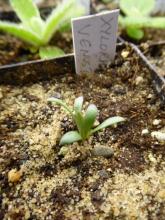
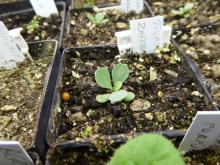
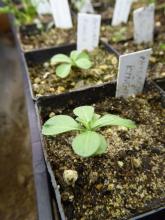
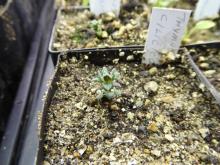
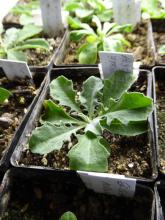
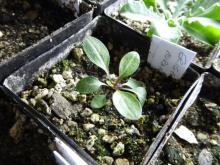
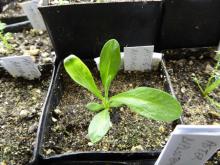
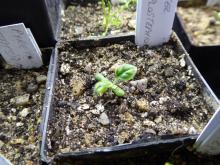
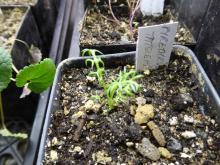
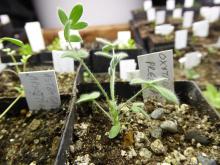
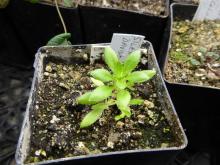
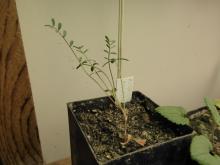
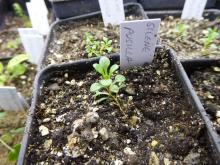
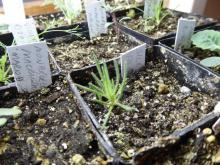
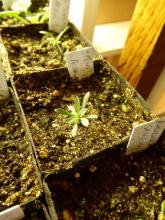
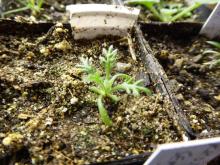
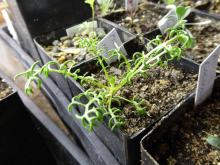
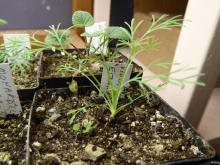
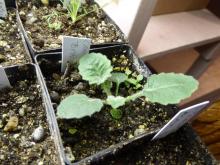
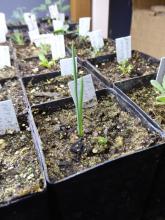
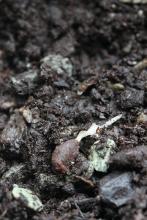
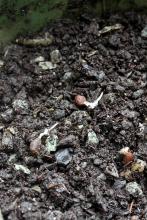
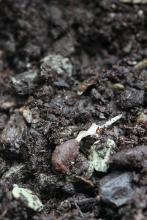
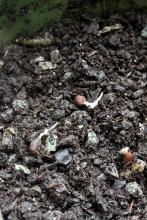
Astragalus aretioides. Seed nicked and soaked last night, sown on filter paper this morning, at about 11 o'clock. (It's 9 p.m. now.)
Seed collected in 1986.